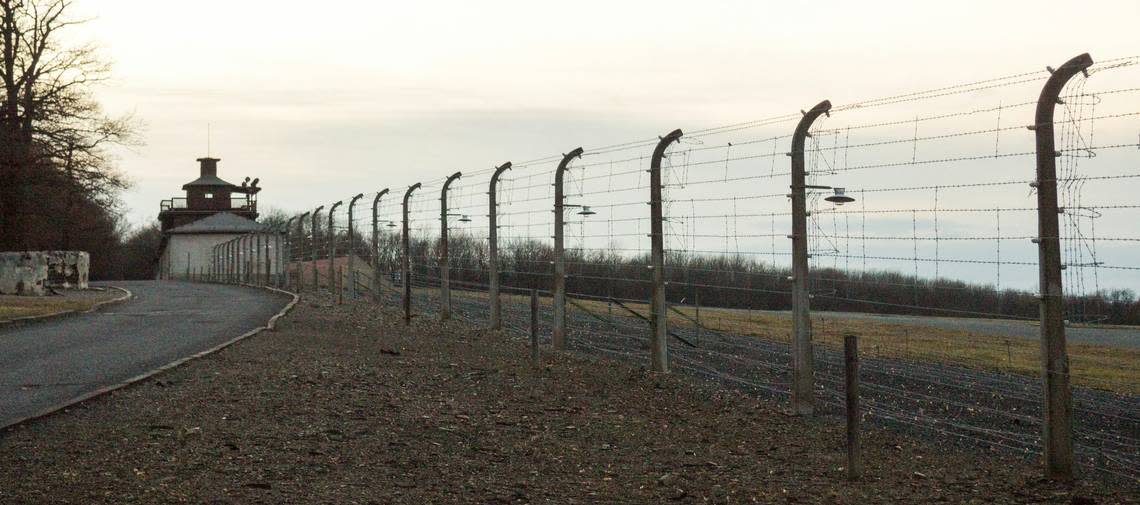Lampshade from Nazi concentration camp is ‘certainly human skin,’ forensic report finds

A forensic analysis confirmed that a small bedside lampshade from a Nazi concentration camp in Germany was “certainly” made of human skin, memorial officials said.
The lampshade is one of several objects made of human remains and treated as “gifts” among Nazi SS soldiers, and serves as yet another testament to the brutality of the Holocaust.
The unsettling artifact “came from one of the houses in the SS villa settlement of the Buchenwald concentration camp,” memorial officials said in a dossier about the forensic analysis published March 21.
The Buchenwald concentration camp was built near Weimar, Germany, in 1937 and operated by Nazi SS soldiers, “the elite guard” of the brutal regime. Over the next eight years, about 277,800 people — primarily Jews but also Jehovah’s Witnesses, Sinti, Roma and those suspected of homosexuality — were held prisoner at the camp. About 56,000 people died at Buchenwald before the camp was liberated in April 1945.
“A speciality of the SS in Buchenwald was the production of macabre ‘gifts’” made of human remains, memorial officials said in the dossier. “Human skin — preferably skin that had been tattooed — was cut from the corpses of inmates, tanned and processed into everyday objects.”
“Hundreds” of pieces of human skin were abused in this way, memorial officials said. The human remains were turned into “objects such as pocket knife cases and lampshades.”
After the camp was liberated, memorial officials said the human remains were kept as evidence of the crimes committed.
A German political prisoner initially took the small lampshade after the camp was liberated. Eventually, the artifact was handed over to officials and returned to Buchenwald for its memorial museum, memorial officials said.
The lampshade, a generally normal-looking object with a tannish color, was “originally assumed” to be made of human skin, memorial officials said. A forensic report in 1992 cast doubt on this assumption but could not “completely” rule it out.
The Buchenwald Memorial commissioned a new forensic analysis of the lampshade and other objects suspected of being human remains in 2023. The analysis was carried out by Mark Benecke, a forensic expert, and involved several laboratories.
The analysis concluded the small lampshade was “certainly human skin” based on “microscopic and genetic examinations,” memorial officials said.
The lampshade was removed from public display in the 1990s due to ethical concerns. The memorial said it “deliberately [does] not show any human remains in our exhibitions, even though they are in our collection.”
Benecke presented the report’s findings at a March 21 news conference, according to a news release from the Austria Press Agency. He described the patterns in the lampshade material as being identifiably human and said he could not understand how the 1992 report reached an uncertain conclusion.
Jens-Christian Wagner, the director of the Buchenwald Memorial foundation, said at the conference that the lampshade’s production and gift-like function showed how dehumanized the Nazi SS soldiers were.
Objects made of human remains were only produced at the Buchenwald concentration camp and no other German camps, Wagner said in the release.
The forensic analysis is still examining several other objects suspected of being made of human remains. The memorial is trying to reconstruct the history of the 12 objects made of human remains in their collection.
The Buchenwald concentration camp is now a memorial to the six million Jewish people killed during the Holocaust. The site is open to visitors and about 180 miles southwest of Berlin.
Google Translate was used to translate the news release from the Austria Press Agency.
Hitler ordered German synagogue destroyed 85 years ago. The ruins vanished — until now
Evidence of uprising against Nazis is found in the ruins of Warsaw ghetto, experts say
Polish family fleeing Nazis abandoned ancient artifacts. Now they’ve been found

